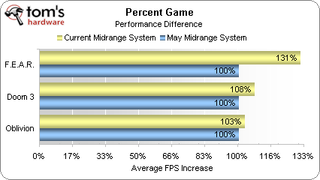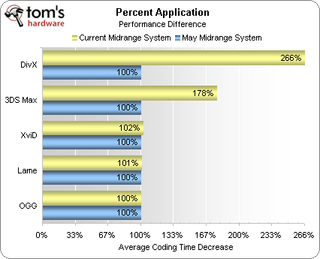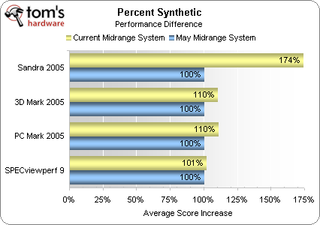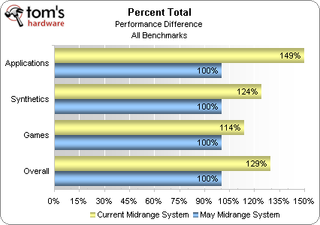SBM 2: Mid Cost System
Conclusion
These builds are designed around the idea that most users already have peripherals and a Windows XP license that they can transfer from their current system to a new one. Taking just the hardware into consideration, we compiled the following price list:
| Current Mid-Priced PC Component Cost | ||
|---|---|---|
| CPU | Intel Core 2 Quad Q6600 | 280 |
| CPU Cooler | Thermalright Ultra-120 Extreme | 65 |
| CPU Fan | Scythe S-Flex SFF21F | 15 |
| Motherboard | MSI P6N SLI Platinum | 140 |
| RAM | PDP Patriot PC2-6400 PDC22G6400LLK | 110 |
| Graphics | EVGA GeForce 8800GTX PN: 768-P2-N831-AR | 520 |
| Hard Drive | Western Digital Caviar RE2 WD5000YS | 155 |
| Case | SILVERSTONE TEMJIN SST-TJ02SW | 100 |
| Power | AeroCool ZERODBA-S620 | 125 |
| DVD-RW | Sony NEC Optiarc 7170 SATA | 35 |
| Total Price | $1,545 |
The total cost of $1545 doesn't even come close to our planned $2000 budget limit, in fact it's only around 20% more than our previous mid-priced build. Let's consider what the older system would cost at today's component prices:
| Former Mid-Priced PC Component Cost (Prices Updated) | ||
|---|---|---|
| CPU | Core 2 Duo E6600 | 230 |
| CPU Cooler | Cooler Master Hyper TX | 30 |
| Motherboard | MSI P965 Platinum | 125 |
| RAM | Patriot eXtreme Performance PDC22G6400LLK | 110 |
| Graphics | EVGA GeForce 8800GTS PN: 320-P2-N811-AR | 290 |
| Hard Drive | Western Digital Caviar RE2 WD5000YS | 155 |
| Case | SILVERSTONE TEMJIN SST-TJ02SW | 100 |
| Power | AeroCool ZERODBA-S620 | 125 |
| DVD-RW | Sony NEC Optiarc Black AD-7170S-0B 18X SATA | 35 |
| Total Price | $1,200 |
After price correction, the new system is 28.8% costlier than the former configuration. Will it provide the 29% performance increase needed to maintain proper value?

A huge increase in graphics card price netted us a comparatively small 14% average gain in games. Surely the four-core processor will prove more beneficial in applications.

The abnormally high DivX encoding time gains of the four-core Intel Core 2 Quad are tamed a bit by the fact that four out of six applications gained nothing. Still, we see an overall application performance gain of around 49%.
Synthetics gauge a wider range of performance than a few sample programs, so let's see what differences these show.

Though Sandra 2005 showed a substantial overall gain of 74%, the average score increase across all synthetics is only 24%.
Stay on the Cutting Edge
Join the experts who read Tom's Hardware for the inside track on enthusiast PC tech news — and have for over 25 years. We'll send breaking news and in-depth reviews of CPUs, GPUs, AI, maker hardware and more straight to your inbox.
What happens when we average everything together?

For 29% more money, we got a 29% performance increase. Bang-for-the-buck appears to be a tie between our former and later mid-priced systems, but we have yet to try our hand at overclocking. Also stay tuned for a comparison of all three systems from this week's System Builder Marathon.
Author's Opinion
Don Woligroski's low-cost system may once again take the eventual bang-for-the-buck win, as its 8800GTS is much cheaper than the 8800GTX we used today and not that much slower. We still haven't considered overclocking, either, where every Core 2 Duo E6750 we've seen uses the latest stepping while our recently-purchased Q6600 did not.
It seems that our greatest hope for this mid-priced build is that Shelton Romhanyi is a better overclocker than Don!
Most Popular

